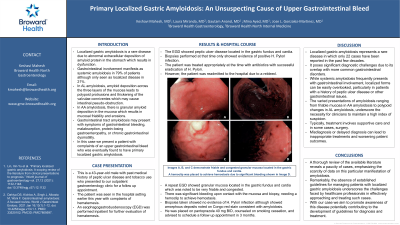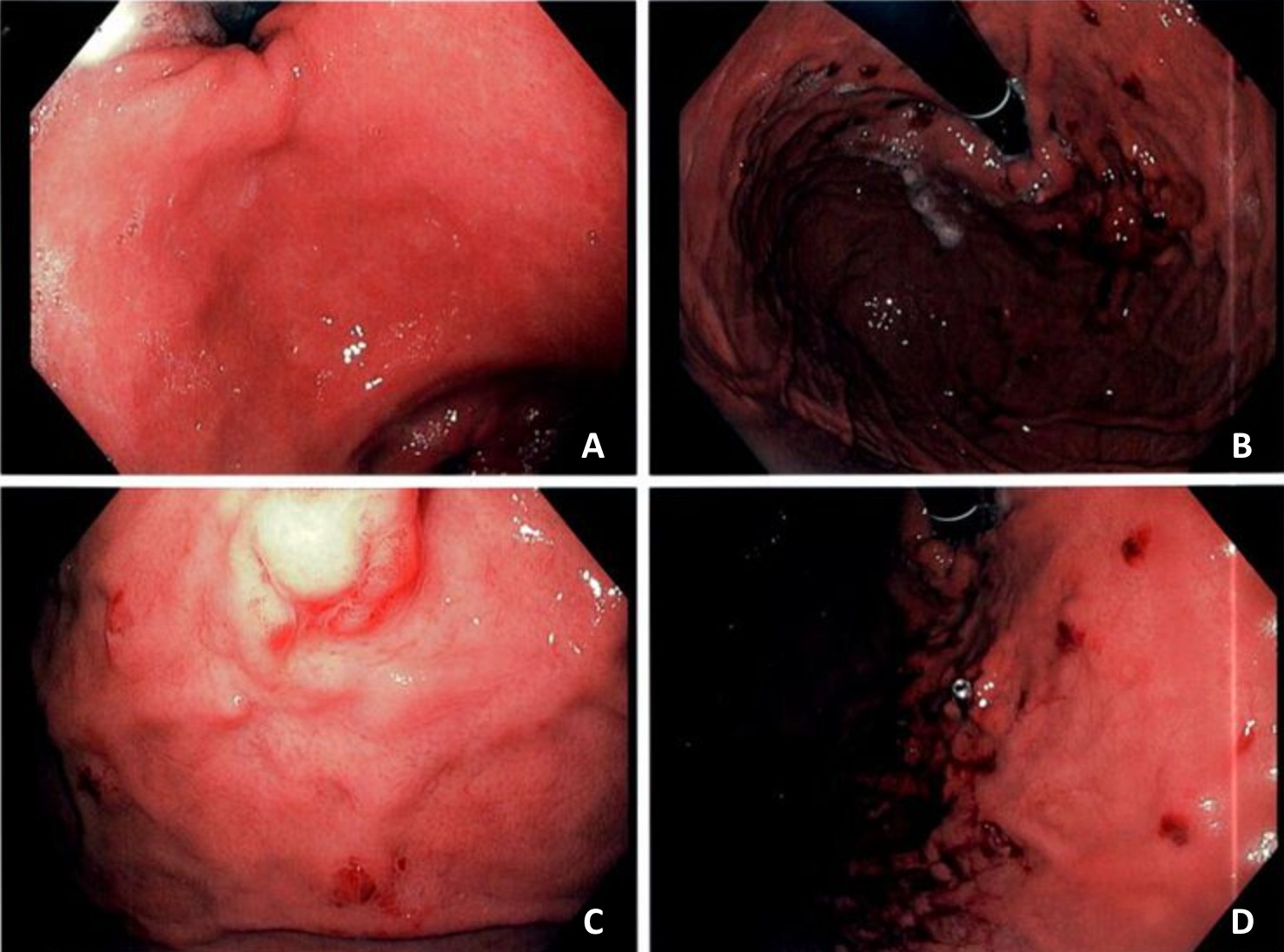Tuesday Poster Session
Category: Stomach
P5101 - Primary Localized Gastric Amyloidosis: An Unsuspecting Cause of Upper Gastrointestinal Bleed
Tuesday, October 29, 2024
10:30 AM - 4:00 PM ET
Location: Exhibit Hall E

Has Audio

Keshavi Mahesh, MD
Broward Health North
Pompano Beach, FL
Presenting Author(s)
Keshavi Mahesh, MD1, Jose Gonzalez-Martinez, MD2, Laura Miranda, MD1
1Broward Health North, Pompano Beach, FL; 2Broward Health North, Hollywood, FL
Introduction: Localized gastric amyloidosis is a rare disease due to abnormal extracellular deposition of amyloid protein in the stomach. Gastrointestinal involvement manifests as systemic amyloidosis in 79% of patients although only seen as localized disease in 21%. In AA amyloidosis, there is granular amyloid deposition in the mucosa which results in mucosal friability and erosions. Gastrointestinal tract amyloidosis may present with symptoms of gastrointestinal bleeding, malabsorption, protein-losing gastroenteropathy, or chronic gastrointestinal dysmotility. In this case we present a patient with complaints of an upper gastrointestinal bleed who was eventually found to have primary localized gastric amyloidosis.
Case Description/Methods: A 43-year-old male with past medical history of peptic ulcer disease and tobacco use presented to our outpatient gastroenterology clinic for a follow up appointment. He was seen in the hospital setting earlier this year with complaints of hematemesis. An EGD was performed inpatient which showed peptic ulcer disease located in the gastric fundus and cardia. Biopsies showed evidence of positive H. Pylori infection. The patient was treated appropriately at the time with antibiotics with successful eradication of H. Pylori. However, the patient was readmitted to the hospital due to a rebleed. A repeat EGD showed granular mucosa located in the gastric fundus and cardia which was noted to be very friable and congested. There was significant bleeding upon contact with the mucosa and biopsy, needing a hemoclip to achieve hemostasis. Biopsies taken at that time showed amorphous deposits noted on Congo red stain consistent with amyloidosis. He was placed on pantoprazole 40 mg BID, counseled on smoking cessation, and advised to schedule a follow up appointment in 3 months.
Discussion: Localized gastric amyloidosis represents a rare disease in which only 22 cases have been reported in the past few decades. Typically, treatment involves supportive care and in some cases, surgery. A thorough review of the available literature reveals a paucity of cases, emphasizing the scarcity of data on this particular manifestation of amyloidosis. The absence of established guidelines for managing patients with localized gastric amyloidosis underscores the challenges faced by healthcare professionals in effectively approaching and treating such cases. With our case we aim to promote awareness of this disease potentially contributing to the development of guidelines for diagnosis and treatment.

Disclosures:
Keshavi Mahesh, MD1, Jose Gonzalez-Martinez, MD2, Laura Miranda, MD1. P5101 - Primary Localized Gastric Amyloidosis: An Unsuspecting Cause of Upper Gastrointestinal Bleed, ACG 2024 Annual Scientific Meeting Abstracts. Philadelphia, PA: American College of Gastroenterology.
1Broward Health North, Pompano Beach, FL; 2Broward Health North, Hollywood, FL
Introduction: Localized gastric amyloidosis is a rare disease due to abnormal extracellular deposition of amyloid protein in the stomach. Gastrointestinal involvement manifests as systemic amyloidosis in 79% of patients although only seen as localized disease in 21%. In AA amyloidosis, there is granular amyloid deposition in the mucosa which results in mucosal friability and erosions. Gastrointestinal tract amyloidosis may present with symptoms of gastrointestinal bleeding, malabsorption, protein-losing gastroenteropathy, or chronic gastrointestinal dysmotility. In this case we present a patient with complaints of an upper gastrointestinal bleed who was eventually found to have primary localized gastric amyloidosis.
Case Description/Methods: A 43-year-old male with past medical history of peptic ulcer disease and tobacco use presented to our outpatient gastroenterology clinic for a follow up appointment. He was seen in the hospital setting earlier this year with complaints of hematemesis. An EGD was performed inpatient which showed peptic ulcer disease located in the gastric fundus and cardia. Biopsies showed evidence of positive H. Pylori infection. The patient was treated appropriately at the time with antibiotics with successful eradication of H. Pylori. However, the patient was readmitted to the hospital due to a rebleed. A repeat EGD showed granular mucosa located in the gastric fundus and cardia which was noted to be very friable and congested. There was significant bleeding upon contact with the mucosa and biopsy, needing a hemoclip to achieve hemostasis. Biopsies taken at that time showed amorphous deposits noted on Congo red stain consistent with amyloidosis. He was placed on pantoprazole 40 mg BID, counseled on smoking cessation, and advised to schedule a follow up appointment in 3 months.
Discussion: Localized gastric amyloidosis represents a rare disease in which only 22 cases have been reported in the past few decades. Typically, treatment involves supportive care and in some cases, surgery. A thorough review of the available literature reveals a paucity of cases, emphasizing the scarcity of data on this particular manifestation of amyloidosis. The absence of established guidelines for managing patients with localized gastric amyloidosis underscores the challenges faced by healthcare professionals in effectively approaching and treating such cases. With our case we aim to promote awareness of this disease potentially contributing to the development of guidelines for diagnosis and treatment.

Figure: Images A, B, and C demonstrate friable and congested granular mucosa located in the gastric fundus and cardia. A hemoclip was placed to achieve hemostasis due to significant bleeding shown in Image D.
Disclosures:
Keshavi Mahesh indicated no relevant financial relationships.
Jose Gonzalez-Martinez indicated no relevant financial relationships.
Laura Miranda indicated no relevant financial relationships.
Keshavi Mahesh, MD1, Jose Gonzalez-Martinez, MD2, Laura Miranda, MD1. P5101 - Primary Localized Gastric Amyloidosis: An Unsuspecting Cause of Upper Gastrointestinal Bleed, ACG 2024 Annual Scientific Meeting Abstracts. Philadelphia, PA: American College of Gastroenterology.
